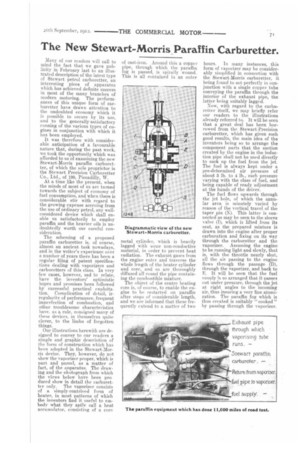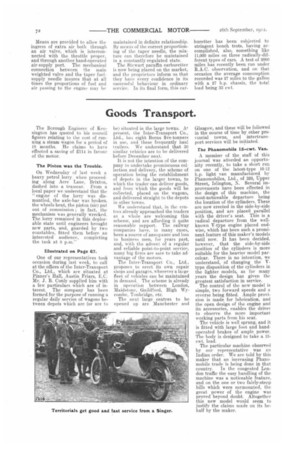The New Stewart-Morris Paraffin Carburetter.
Page 11

Page 12

If you've noticed an error in this article please click here to report it so we can fix it.
Many of our readers will call to mind the fact that we gave publicity in February last to an illustrated description of the latest type of Stewart petrol carburetter, an interesting piece of apparatus which has achieved definite success 3T1 most of the many branches of modern motoring. The performances of this unique form of carburetter have drawn attention to the undoubted economy which it is possible to secure by its use, and .to the generally-satisfactory running of the various types of engines in conjunction with which it has been employed.
It was therefore with considerable anticipation of a favourable nature that, during the past week, we took the opportunity which was afforded to Us of examining the new Stewart-Morris paraffin carburetter, of which the sole proprietor is the Stewart Precision Carburetter Co., Ltd., of 199, Piccadilly, W.
At a time like the present, when the minds of most of us are turned towards the subject of economy of fuel consumption, and when there is considerable stir with regard to the growing expense accruing from the use of ordinary petrol, any wellconsidered device which shall enable us satisfactorily to employ paraffin and the heavier oils is undoubtedly worth our careful consideration.
The scheming of a proposed paraffin carburetter is, of course, almost an ancient task nowadays, and in the writer's experience over a number of years there has been a regular filing of patent specifications dealing with vaporizers and carburetters of this class. In very few cases, however, sad to relate, have the inventors' optimistic hopes and promises been followed by successful practical exploitation. Complication of detail, irregularity of performance, frequent imperfection of combustion,. and other troublesome characteristics have, as a rule, consigned many of these devices, in themselves quite clever, to the limbo of forgotten things.
Our illustrations herewith are designed to convey to our readers a simple. and graphic descrintion of the form of construction which has been adopted in the Stewart-Morris device, They, however, do not. show the vaporizer proper, which is part and parcel, as a matter of fact, of the anparatus. The drawing and the Photograph from which the views below have been produced show in detail the carburetter only. The vaporizer consists of a simply contrived form of heater, in most patterns of which the inventors find it useful to embody what they aptly call a heat accumulator, consisting of a core
of cast-iron. Around this a copper pipe, through which the paraffin i fog s passed, is spirally wound. This is all contained in an outer metal cylinder, which is heavily lagged with some non-conductive material, in order to prevent heat radiation. The exhaust gases from the engine enter and traverse the whole length of the heater cylinder and core, and so are thoroughly diffused all round the pipe containing the combustible mixture.
The object of the centre heating core is, of course, to enable the engine to be. restarted on paraffin after stops of considerable length, and we are informed that these frequently extend to a matter of two
hours. In many instances, this form of vaporizer may be considerably simplified in connection with the Stewart-Morris carburetter, it being found to act perfectly in conjunction with a single copper tube conveying the paraffin through the interior of the exhaust pipe, the latter being suitably lagged.
Now, with regard to the carburetter itself, we may briefly refer our readers to the illustrations already referred to. It will be seen that a great deal has been borrowed from the Stewart-Precision carburetter, which has given such good results, the main idea of the inventors being so to arrange the component parts that the suction created by the engine in the induction pipe shall not be used directly to suck up the fuel from the jet. The fuel is always kept under a pre-determined air pressure of about 3 lb. to 4 lb., such pressure varying with the class of fuel, and being capable of ready adjustment at the hands of the driver,
The fuel flows upwards through the jet hole, of which the annular area is minutely varied by reason of the vertical travel of the taper pin (N). This latter is connected as may be seen to the sleeve valve (T), which is lifted from its seat, as the prepared mixture is drawn into the engine after proper carburation and fixing on its way through the carburetter and the vaporizer. Assuming the engine to be running light and slowly, that is, with the throttle nearly shut, all the air passing to the engine flows through the passage (D), through the vaporizer, and back to E. It will be seen that the fuel supply is so arranged that it passes out under pressure, through the jet at right angles to the incoming air, thus insuring a very fine atomization. The paraffin fog which is thus created is suitably " cooked " by passing through the vaporizer.
Means are provided to allow the ingress of extra air both through an air valve, which is interconnected with the throttle proper, and through another hand-operated air-supply port. The mechanical connection between the main weighted valve and the taper fuelsupply needle insures that at all times the proportions of fuel and air passing to the engine may be maintained in definite relationship. By ['leans of the correct proportioning of the taper needle, the mixture can therefore be maintained in a constantly-regulated state.
The Stewart paraffin carburetter is now being placed on the market, and the proprietors inform us that they have every confidence in its successful behaviour in ordinary service. In its final form, this car
buretter has been subjected to stringent bench tests, having accomplished, also, something like 11,000 miles on three radically-different types of cars. A test of 2000 miles has recently been run under R.A.C. observation, and on that occasion the average consumption recorded was 27 miles to the gallon with a 27 h.p. chassis, the total load being 33 cwt.






















